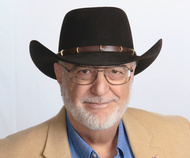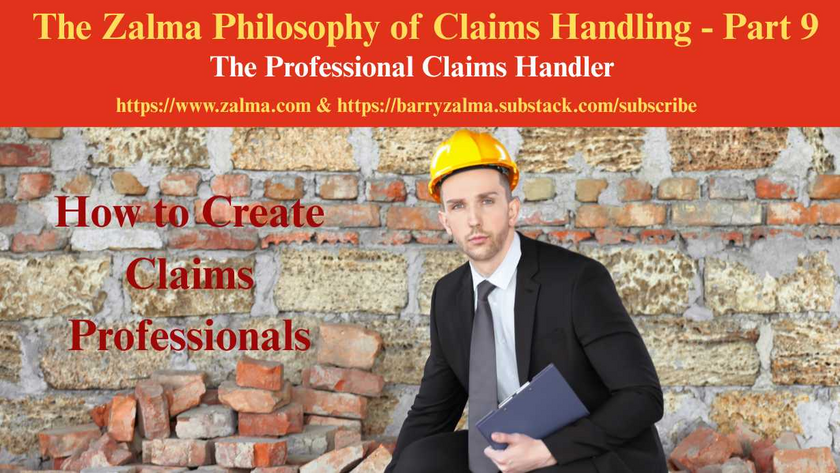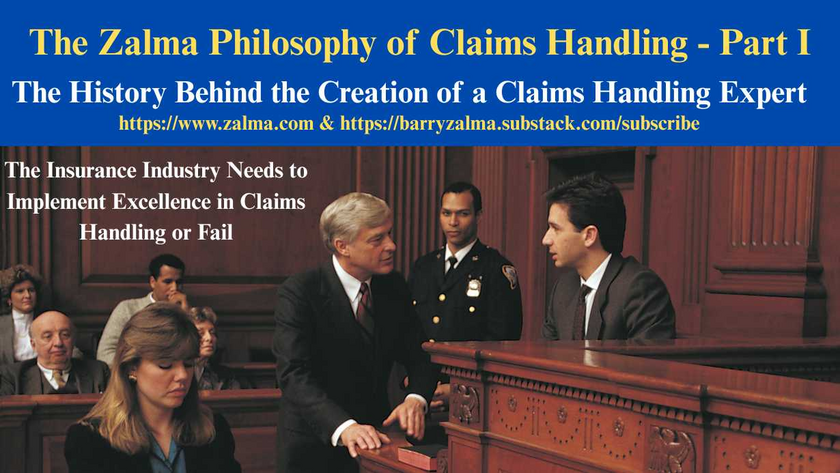
Fictionalized True Story of Insurance Fraud
Barry Zalma
Oct 26, 2023
Read the full article and true crime story at https://lnkd.in/gf_WMMW8 and shttps://lnkd.in/g4uNbMRx and at https://zalma.com/blog plus more than 4600 posts.
"The story that follows is a fictionalized true crime story of Insurance Fraud from an Expert who explains why Insurance Fraud is a “Heads I Win, Tails You Lose” situation for Insurers. The story is presented to help everyone to understand how insurance fraud in America is costing everyone who buys insurance thousands of dollars every year and why insurance fraud is safer and more profitable for the perpetrators than any other criminal activity."
Unfortunately, like Every Profession, Some are not Honorable and This Story is Presented to Warn Insurers and Professional Public Adjusters How to Recognize the Amoral Members of the Profession
Public adjusters, like personal injury lawyers, work on a contingency fee. For a percentage of the recovery, they present claims on behalf of insureds to insurance companies. Like personal injury lawyers, some are honest and some are not. The public adjuster who is the subject of this tale is one of the latter.
This amoral public adjuster profits from the misery and grief of unfortunate people who suffer loss. His car is equipped with a multi-band scanner turned to all of the fire department frequencies. When he hears of a fire on his scanner he drives directly to the scene. He has been known to arrive before the fire engines.
In his briefcase he carries glossy brochures explaining what services he provides and how insurers will take advantage of innocent insureds not represented by amoral public adjusters. While the embers of their house cool, he has the homeowners sign a contingency fee contract promising to take care of all their needs.
Because state law requires that the contract have a seventy-two-hour cancellation clause he does nothing for the first three days, except leave the property owner with blank inventory forms upon which he has instructed them to write a description of every item of property in their house.
Once the seventy-two hours have expired and the contract can no longer be canceled, he calls in contractors and furniture restorers to prepare estimates for the restoration of the house and its contents.
Each of the contractors knows that they will not be called unless they have already agreed to pay the amoral public adjuster, in cash, 15 percent (15%) of the contract amount. Each of the contractors, therefore, bid their work at a price at least twenty-five to thirty percent higher than necessary to restore the damaged property using material of like kind and quality as existed before the fire. The contractors understood that a reasonable profit can only be made if the insurance company pays the inflated estimate. The company adjuster can adjust the estimate downward and they will still have enough profit left over to pay the amoral public adjuster.
The amoral public adjuster also has in his office computers a schedule of household goods. Whatever claim he adjusts; the same list of household goods is presented to the insurance company adjuster. The list always contains ten cans of Libby peas, four cans of Libby string beans, five cans of Del Monte tomato sauce, and twenty can of Campbell pea soup. Every schedule prepared by the amoral public adjuster shows a thirteen-inch Sony Trinitron color television with remote control in the kitchen and a 50 inch HD TV in the family room. The living room always contains a complete entertainment center with sixty inch televisions hung on the wall, a TiVo, a stereo and a CD player. The amoral public adjuster does not even attempt to find out what was actually in the insured’s house.
Invariably, because of the extent of the list of personal property, the insured’s claim is invariably greater than their policy limit.
The amoral public adjuster is happiest when the loss exceeds the policy limit. This gives the adjuster for the insurance company the opportunity to negotiate depreciation off the total value of the claimed lost property without ever reaching a number less than the policy limits.
The amoral public adjuster’s success relied on the fact that the company’s adjuster is overworked, underpaid and under-trained. The company adjuster does not have the time to thoroughly investigate each fire loss. He must rely on the honesty of the insured and the contractors bidding on the repair work. If the adjuster doesn’t go out and look, there is no way for the adjuster to know that there was no television in the insureds’ second bedroom. If he doesn’t look, he will never know that the insureds had never purchased Libby products in their life, or that the house was not large enough to hold all of the personal property claimed destroyed in the fire. Since the company adjuster had 200 fire claims pending and a supervisor, who insisted that he close no less than 50 claims a month, the adjuster had no choice but to believe the presentation made by the amoral public adjuster. He depreciated the personal property, eliminated duplications on a construction estimate, and prepared a well-written report establishing that the loss exceeded policy limits. His superiors immediately provided him authority to the insured and the public adjuster. The amoral public adjuster collected 10% of the total amount of the loss from the insured.
He added to his profit with an additional 15% from the contractors. The adjuster closed one more file and pleased his supervisor. The insured received enough money to repair his house and replace his personal property.
Auditors reviewed the file and found it well documented with two reconstruction estimates, an investigation report prepared by the adjuster, and photographs of the dwelling. On paper the adjustment was excellent. The statement of loss was prepared in the proper format. Drafts were drawn properly; all codes were entered and appropriate reserves were submitted. There was no need for the expensive services of independent adjusters, surveyors, construction consultants, engineers or attorneys. As a result of similar good work, the adjuster was promoted to claims supervisor.
If the insurer's adjuster only had 50 fire claims pending and, therefore, the time to make a complete and full investigation of the fire scene, he would have learned the following:
More than 40% of the personal property claimed destroyed in the fire was not in the residence.
The general contractor’s estimate to repair the building added eighteen inches to every dimension of every room. This additional square footage inflated the fire repair estimate 25 percent.
If he had inspected the premises closely and done a complete scope of loss, he would have noted that the hardwood floors throughout the dwelling were actually plywood sub-flooring covered with carpet.
He would also have learned that there was no service porch as called for in the repair estimates, nor was there any vinyl wall covering.
Had he inspected carefully, he would have noted that a kitchen larder was bare and the refrigerator contained only a quart of milk, two eggs and half a package of bacon.
If his company had authorized the purchase of overalls rather than requiring him to wear a business suit on all calls, he would have been able to go into the debris to find that the only remains of a television in the entire house were a single thirteen inch J.C. Penney black and white television.
If the adjuster had any training in fire cause investigation, he would have noted the flammable liquid trails on the carpet in the living room, dining room, kitchen and master bath.
If his sinuses weren’t plugged, he would have smelled the gasoline still liquid in the bathroom carpet.
He didn’t have the time, he didn’t have the training, and he didn’t have the support. He talked to the insured on the telephone who told him he was away from the house when the fire happened. The adjuster had a contractor he knew prepare an estimate which he used as the basis of his adjustment. The contractor was introduced to the adjuster by the amoral public adjuster.
The adjuster never saw the dwelling. He trusted his contractor and the amoral public adjuster to do his work for him. The insured got their house fixed and more money than they were entitled to receive. The amoral public adjuster collected 25% of the total payment for a total of five hours work. The contractor, even after paying 15% to the amoral public adjuster, made a profit of 40% and did only the least amount necessary to repair the house rather than the maximum amount specified on the reconstruction estimate.
The fraud was perfect. The perpetrators and the victims alike, were satisfied.
If the insurance industry believes it is saving money by under staffing, under paying and failing to properly train its adjusters, it is sorely mistaken.
I submit that the most effective means of defeating fraudulent insurance claims would be for the insurance industry to recognize that its staff of adjusters must be highly trained professionals who earn the best wage in the insurance company and who are motivated and rewarded for good work. Adjusters must be compensated and rewarded for the quality of their work, not the quantity.
Very few public adjusters are amoral. In fact, their national organization, requires they submit to the NAPIA code of ethics. [http://www.napia.com]
If the amoral public adjuster followed the NAPIA code he would be the Moral Public Adjuster.
This article was adapted from my book Insurance Fraud Costs Everyone available at amazon.com and the Insurance Claims Library – http://zalma.com/blog/insurance-claims-l
(c) 2023 Barry Zalma & ClaimSchool, Inc.
Please tell your friends and colleagues about this blog and the videos and let them subscribe to the blog and the videos.
Subscribe to Excellence in Claims Handling at locals.com at https://zalmaoninsurance.locals.com/subscribe or at substack at https://barryzalma.substack.com/publish/post/107007808
Go to Newsbreak.com https://www.newsbreak.com/@c/1653419?s=01
Follow me on LinkedIn: http://www.linkedin.com/comm/mynetwork/discovery-see-all...
Daily articles are published at https://zalma.substack.com.
Go to the podcast Zalma On Insurance at https://podcasters.spotify.com/pod/show/barry-zalma/support; Go to Barry Zalma videos at Rumble.com at https://rumble.com/c/c-262921; Go to Barry Zalma on YouTube- https://www.youtube.com/channel/UCysiZklEtxZsSF9DfC0Expg; Go to the Insurance Claims Library – http://zalma.com/blog/insurance-claims-l
Please tell your friends and colleagues about this blog and the videos and let them subscribe to the blog and the videos. Subscribe to my substack at https://lnkd.in/gcZKhG6g
Insurer’s Exclusion for Claims of Assault & Battery is Effective
Post 5250
Read the full article at https://lnkd.in/gBzt2vw9, see the video at https://lnkd.in/gEBBE-e6 and at https://lnkd.in/gk7EcVn9, and at https://zalma.com/blog plus more than 5250 posts.
Bar Fight With Security is an Excluded Assault & Battery
In The Cincinnati Specialty Underwriters Insurance Company v. Mainline Private Security, LLC, et al., Civil Action No. 24-3871, United States District Court, E.D. Pennsylvania (December 16, 2025) two violent attacks occurred in Philadelphia involving young men, Eric Pope (who died) and Rishabh Abhyankar (who suffered catastrophic injuries). Both incidents involved security guards provided by Mainline Private Security, LLC (“Mainline”) at local bars. The estates of the victims sued the attackers, the bars, and Mainline for negligence and assault/battery. The insurer exhausted a special limit and then denied defense or indemnity to Mainline Private Security.
INSURANCE COVERAGE
Mainline had purchased a commercial ...
Marine Insurer May Dispose of Vessel to Avoid Waste
Post 5249
Read the full article at https://lnkd.in/gfn_UHdp, see the video at https://lnkd.in/gDWVccnr and at https://lnkd.in/gv9nsBqk, and https://zalma.com/blog plus more than 5200 posts.
In Western World Insurance Company v. The Estate Of Shawn Arsenault, No. 25-cv-13413-PGL, United States District Court, D. Massachusetts (December 17, 2025) the USDC was asked to resolve a marine insurance dispute after the sinking of the F/V Seahorse, a commercial fishing vessel, off Cape Cod on June 8, 2025. The vessel’s owner and operator, Shawn Arsenault, died in the incident.
Western World Insurance Company issued a hull insurance policy for the vessel. With no personal representative yet appointed for the estate, the insurer cannot determine the proper payee for the insurance proceeds.
The insurer paid for the vessel’s recovery and removal, and the vessel is now with a salvage company, incurring substantial storage fees. The insurer determined the loss is covered under the ...
Marine Insurer May Dispose of Vessel to Avoid Waste
Post 5249
Read the full article at https://lnkd.in/gfn_UHdp, see the video at https://lnkd.in/gDWVccnr and at https://lnkd.in/gv9nsBqk, and https://zalma.com/blog plus more than 5200 posts.
In Western World Insurance Company v. The Estate Of Shawn Arsenault, No. 25-cv-13413-PGL, United States District Court, D. Massachusetts (December 17, 2025) the USDC was asked to resolve a marine insurance dispute after the sinking of the F/V Seahorse, a commercial fishing vessel, off Cape Cod on June 8, 2025. The vessel’s owner and operator, Shawn Arsenault, died in the incident.
Western World Insurance Company issued a hull insurance policy for the vessel. With no personal representative yet appointed for the estate, the insurer cannot determine the proper payee for the insurance proceeds.
The insurer paid for the vessel’s recovery and removal, and the vessel is now with a salvage company, incurring substantial storage fees. The insurer determined the loss is covered under the ...
Zalma’s Insurance Fraud Letter
Read the full article at https://lnkd.in/dG829BF6; see the video at https://lnkd.in/dyCggZMZ and at https://lnkd.in/d6a9QdDd.
ZIFL Volume 29, Issue 24
Subscribe to the e-mail Version of ZIFL, it’s Free! https://visitor.r20.constantcontact.com/manage/optin?v=001Gb86hroKqEYVdo-PWnMUkcitKvwMc3HNWiyrn6jw8ERzpnmgU_oNjTrm1U1YGZ7_ay4AZ7_mCLQBKsXokYWFyD_Xo_zMFYUMovVTCgTAs7liC1eR4LsDBrk2zBNDMBPp7Bq0VeAA-SNvk6xgrgl8dNR0BjCMTm_gE7bAycDEHwRXFAoyVjSABkXPPaG2Jb3SEvkeZXRXPDs%3D
Zalma’s Insurance Fraud Letter (ZIFL) continues its 29th year of publication dedicated to those involved in reducing the effect of insurance fraud. ZIFL is published 24 times a year by ClaimSchool and is written by Barry Zalma. It is provided FREE to anyone who visits the site at http://zalma.com/zalmas-insurance-fraud-letter-2/
Zalma’s Insurance Fraud Letter
Merry Christmas & Happy Hannukah
Read the following Articles from the December 15, 2025 issue:
Read the full 19 page issue of ZIFL at ...
The Professional Claims Handler
Post 5219
Posted on October 31, 2025 by Barry Zalma
An Insurance claims professionals should be a person who:
Can read and understand the insurance policies issued by the insurer.
Understands the promises made by the policy.
Understand their obligation, as an insurer’s claims staff, to fulfill the promises made.
Are competent investigators.
Have empathy and recognize the difference between empathy and sympathy.
Understand medicine relating to traumatic injuries and are sufficiently versed in tort law to deal with lawyers as equals.
Understand how to repair damage to real and personal property and the value of the repairs or the property.
Understand how to negotiate a fair and reasonable settlement with the insured that is fair and reasonable to both the insured and the insurer.
How to Create Claims Professionals
To avoid fraudulent claims, claims of breach of contract, bad faith, punitive damages, unresolved losses, and to make a profit, insurers ...

The History Behind the Creation of a Claims Handling Expert
The Insurance Industry Needs to Implement Excellence in Claims Handling or Fail
Post 5210
This is a change from my normal blog postings. It is my attempt. in more than one post, to explain the need for professional claims representatives who comply with the basic custom and practice of the insurance industry. This statement of my philosophy on claims handling starts with my history as a claims adjuster, insurance defense and coverage lawyer and insurance claims handling expert.
My Training to be an Insurance Claims Adjuster
When I was discharged from the US Army in 1967 I was hired as an insurance adjuster trainee by a professional and well respected insurance company. The insurer took a chance on me because I had been an Army Intelligence Investigator for my three years in the military and could use that training and experience to be a basis to become a professional insurance adjuster.
I was initially sat at a desk reading a text-book on insurance ...














